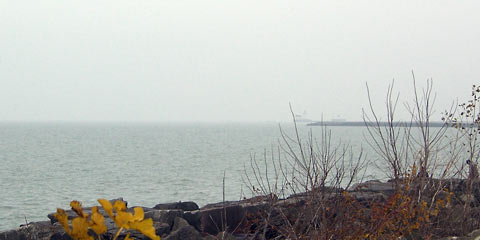Foggy today
 There's something wonderful about those days when it's foggy enough that you can see the horizon but can't tell exactly where air turns into water. The edges of reality are blurred but you don't feel lost.
There's something wonderful about those days when it's foggy enough that you can see the horizon but can't tell exactly where air turns into water. The edges of reality are blurred but you don't feel lost.
It was warm today, almost Spring-like, with a slight drizzle off and on. I ran five miles, expecting that any minute it would start to pour and I'd end up cold and miserable. It didn't, and I felt great.
As I ran I tested in my head a variety of responses to a recent email, but no brilliant ideas.
Top |
|
![]()
Storymapping
The other day I was thinking that maybe we need to change for focus of the Interactive Media class that I teach once a year at Tri-C. In the past we've always started with learning how a linear (beginning-middle-end) story works. This makes perfect sense for linear media, like books, film and video, but may be slowing us down in developing interactive stories. The essence of an interactive story is not a start-to-finish journey, but an exploration of a space. The space can be an information space (exploring a topic or idea) or a geographic space (exploring a neighborhood or a city).
While doing a bit of web-research this afternoon trying to find a good entry-level video camera I came across Storymapping.org, an offshoot of the long-established Center for Digital Storytelling. Storymapping is a great term that encompasses a big part of what I think we need to focus on in the class. Here's a description of storymapping from the website:
Whether it is geo-tagging images on Flickr, building story-based Google Maps, developing Windows Live virtual tours, organizing local cell phone walking tours, or the permanent imbedding stories into locations to be received by Bluetooth and other wireless information, we can now create maps that share stories about the places that matter to us, and place our life stories in countless geographic contexts.
Interesting work is already being done by folks in Toronto that go by the name Murmur, so maybe a drive up north may be in order. They describe themselves as:
... a documentary oral history project that records stories and memories told about specific geographic locations. We collect and make accessible people's personal histories and anecdotes about the places in their neighborhoods that are important to them. In each of these locations we install a [murmur] sign with a telephone number on it that anyone can call with a mobile phone to listen to that story while standing in that exact spot, and engaging in the physical experience of being right where the story takes place.
To this I'd like to add a component of interaction that would allow others to respond or add to the stories. And I'd like to broaden the concept a bit to include mapping non-physical spaces—concepts or imaginary spaces. All extremely interesting. Stay tuned for more. If you have ideas or suggestions on where to go with this idea, please let me know.
Top |
|
![]()